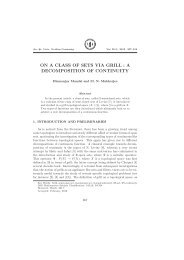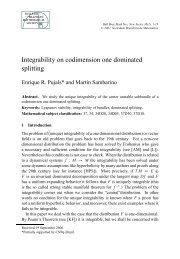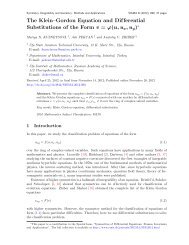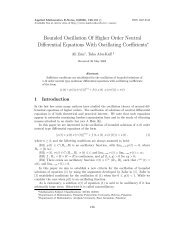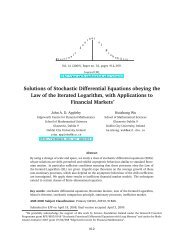ENRICHED INDEXED CATEGORIES Contents 1. Introduction
ENRICHED INDEXED CATEGORIES Contents 1. Introduction
ENRICHED INDEXED CATEGORIES Contents 1. Introduction
Create successful ePaper yourself
Turn your PDF publications into a flip-book with our unique Google optimized e-Paper software.
<strong>ENRICHED</strong> <strong>INDEXED</strong> <strong>CATEGORIES</strong> 651Proof. We prove only (5.25); the others are similar. For any appropriately typed M, wehaveV -PROF ((H ⊙ K) ⊙ L, M) ∼ = V -Bimor((H ⊙ K), L; M)∼ = V -Multimor(H, K, L; M)∼ = V -Bimor(H, K ⊙ L; M)∼ = V -PROF (H ⊙ (K ⊙ L), M).Thus, the Yoneda lemma gives (5.25).5.26. Lemma. For H : A −↦−→ B, the composites H ⊙B and A ⊙H, and the homs B ⊲Hand H ⊳ A , all exist and are canonically isomorphic to H.Proof. Just like the previous lemma.5.27. Remark. We will henceforth abuse language by writing “H ⊙ K ∼ = L” to meanthat the composite H ⊙ K exists and is canonically isomorphic to L, and similarly for leftand right homs.5.28. Lemma. For a V -profunctor H : A −→ −↦ B and a V -functor f : A ′ → A , we haveA (1, f) ⊙ H ∼ = H(1, f). Similarly, for g : B ′ → B, we have H ⊙ B(g, 1) ∼ = H(g, 1).Proof. By [CS10, Theorem 7.16].In particular, for A f −→ B g −→ C , we have B(1, f) ⊙ C (1, g) ∼ = C (1, gf), so thatrepresentable profunctors are “pseudofunctorial”, even though in general, V -profunctorsbetween large V -categories do not form a bicategory. The same proof as in Lemma 3.26shows that this functor is fully faithful, i.e. we have natural bijectionsV -CAT (A , B)(f, g) ∼ = V -PROF (A , B)(B(1, f), B(1, g))∼ = V -PROF (B, A )(B(g, 1), B(f, 1)).The dual statement for homs is the second Yoneda Lemma, as in 3.29.5.29. Lemma. For a V -profunctor H : A −→ −↦ B and a V -functor f : A ′ → A , we haveH ⊳ A (f, 1) ∼ = H(1, f). Similarly, for g : B ′ → B, we have B(1, g) ⊲ H ∼ = H(g, 1).Proof. This follows immediately from [CS10, Theorem 7.20].In particular, although in the statement of Lemma 3.29 we assumed V to be an indexedcosmos so that the homs ⊳ and ⊲ would exist a priori, this version of it shows that thatassumption is unnecessary; the particular homs in question automatically exist.The first Yoneda Lemma 3.28 follows immediately.5.30. Lemma. For any V -functor f : A → B and V -profunctors H : A −→ −↦ B andK : B −→ −↦ A , there are natural bijectionsV -PROF (A , B)(B(1, f), H) ∼ = V -PROF (A , A )(A , H(f, 1))V -PROF (B, A )(B(f, 1), K) ∼ = V -PROF (A , A )(A , K(1, f)).and



